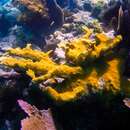Brief Summary
provided by EOL authors
Acropora palmata, or Elkhorn Coral, is considered to be one of the most important reef-building corals in the Caribbean. This species of coral is structurally complex with many large branches that resemble elk antlers and create habitats for many other reef species. Elkhorn coral colonies are fast growing. The color, which ranges from brown to a yellowish-brown, is a result of the symbiotic zooxanthellae that live inside the tissue of this coral species.
Brief Summary
provided by EOL authors
Elkhorn coral (Acropora palmata) is a large, branching coral with thick and sturdy antler-like branches. It is a member of the Acropora genus, the most abundant and species-rich group of corals in the world. Colonies of Elkhorn coral are fast growing - branches increase in length by 2-4 inches (5-10 cm) per year, with colonies reaching their maximum size in approximately 10-12 years. Over the last 10,000 years, elkhorn coral has been one of the three most important Caribbean corals contributing to reef growth and development, as well as providing essential fish and marine invertebrate habitat. While once the most abundant stony coral on shallow reef crests and fore-reefs of the Caribbean and Florida reef tract, by the early 1990s elkhorn coral had experienced widespread losses through its range. Multiple factors are thought to have contributed to coral declines, including impacts from hurricanes, coral disease, mass coral bleaching, climate change, coastal pollution, overfishing, and damage from boaters and divers. In 2006, elkhorn coral and a close relative, staghorn coral (Acropora cervicornis) were listed as threatened under the US Endangered Species Act.
One Species at a Time
provided by EOL authors
Coral reefs are bustling cities of marine life, until rising ocean temperatures turn them into ghost towns. Can reefs spring back from devastating bleaching events? Ari Daniel Shapiro and researcher Dr.Randi Rotjan of the
New England Aquarium, journey to the remote Phoenix Islands to find out.
Listen to the podcast, meet the
featured scientist, see
images of coral reef research in the Phoenix Islands and find relevant
educational resources on the EOL Learning + Education
website.

